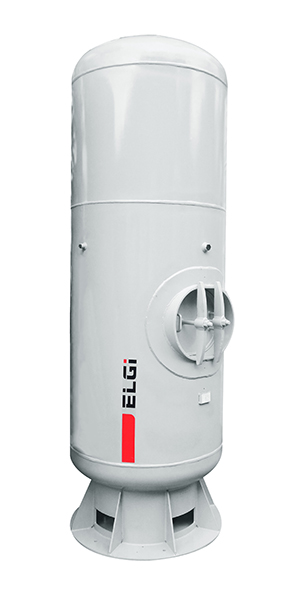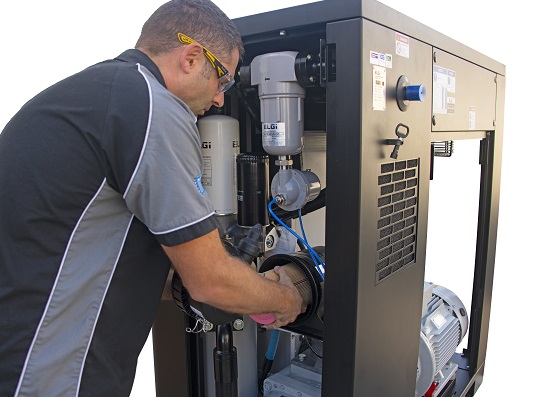Installation of air compressors and accessories, air piping, vacuum, blowers and pneumatics
Compressed Air Controls can install:
- ELGi industrial air compressors and accessories
- Air piping and fittings
- Vacuum
- Blowers
- Pneumatics
Our experienced, qualified Service Technicians can organize all or part of an install, any time of the day. We can conduct installations outside of your production hours.
Our installations include us ensuring there is:
- Adequate ventilation
- Correct piping design
- Condensation waste is draining efficiently
- Pressure vessels/receivers are correctly installed and meet safety requirements
Air compressors, air piping, vacuum, blowers, and pneumatics are installed as per the manufacturer's guidelines and industry best practice
This will make sure that the compressor has a long life and will provide optimum performance, and reduces energy costs.
Bending aluminium air piping would compromise the air piping’s coating and integrity and may cause it to fail.
It is also best practice to ensure that air compressors are not exposed to the elements and are either housed in a shed or some sore of covering is built over it.
These are the five aspects Compressed Air Controls' Service Technicians take into account when deciding where to install the compressor:
1. Location; this is the most important aspect when installing an air compressor
During installation, we need to ensure there is sufficient area available for the:
- Unloading
- Installation
- Operation
- Maintenance of the air compressor.
The designated area must be equipped with enough clearance around it.
For rotary screw compressors, however, no special foundation or anchoring is required. The compressor must be placed on a level surface that can withstand the load of the compressor and the equipment used to move it.
Compressed Air Controls place the compressor so it is protected from the elements and toxic or flammable materials or corrosive agents
“It was rather an ingenious idea as we can move the air compressors around as we need them and it gives us space if we expand the business in the future,” Stevenson Structural Engineers’ Purchasing Manager Tony Twist said.
Tony said the previous air compressor, which was supplied and installed by a different company, had sucked in contaminants from the blast booth beside it, which destroyed its bearings in a Chernobyl-like fashion.
2. Ventilation; a lack of this, and cooling, is the leading cause of trouble in air compressors
The electricity delivered to your compressor is completely transformed into heat during compression and that heat is dissipated into the compressor room.
To make sure your compressor is sufficiently cooled, the following measures can be adopted:
Natural ventilation:
If the temperature inside the compressor room doesn’t exceed 5 ˚C when compared with the ambient temperature, natural ventilation is sufficient.
Forced ventilation:
- Exhaust fan: we will install an exhaust fan if the temperature inside the compressor room exceeds 5 ˚C.
- Ducts: we will ensure the hot air exhaust from the compressor is diverted through ducts when it is installed in an enclosed area. We have a ducting calculator.
We can make winter and summer settings for your ducting so that in the winter the hot air is used to warm your workshop and in the summer it goes outside.
3. Electricals
Compressed Air Controls will make sure that the electrical service voltage matches the voltage on the compressor nameplate (located inside the electrical cabinet) before installing the compressor
The compressor will be:
- Properly grounded
- Properly equipped: The appropriately sized fuse or circuit breaker should be installed between the compressor and the main electric service.
The actual operating voltage must be within +/- 10% of the compressor nameplate voltage. Insufficient or excessive voltage will directly affect the compressor's electrical system.
For variable speed drive units, the Service Technician will make sure that the power supply transformer has a symmetrical, three-phase supply. In a symmetrical three-phase supply, the phase angles and voltage are all the same.
4. Accessories
 Air storage: via an air receiver tank is an integral and important part of any compressed air system
Air storage: via an air receiver tank is an integral and important part of any compressed air system
The selection of an air receiver is crucial to meet the demand of the plant and the effective operation of the compressor (load/unload).
What are the benefits of an air receiver tank?
- The receiver tank acts as a reservoir of compressed air for peak demand.
- The receiver tank helps remove water from the system by allowing the air to cool.
- The receiver tank minimizes pulsation in the system caused by a reciprocating compressor or a cyclic process downstream.
Receiver tanks are required to have a pressure relief valve and a pressure gauge. The relief valve should be set to 10% higher than the working pressure of the system.
It is also important to install a manual or automatic drain on the receiver tank to remove water from the system.
Cold start kits
For customers in certain parts of the country, like Norsewood and the Central North Island, we might suggest that this is a good option. We can also retrofit these.
5. Pipework: The correct size of pipework is important to provide sufficient flow and steady pressure to all points of use
Pipe diameter directly impacts the pressure drop. Discharge piping must be at least the same diameter as the compressor discharge outlet.
Pipe selection directly affects three key elements of a compressed air system (flow, pressure, and air quality). Poor choice of pipe materials, diameter, and layout causes flow restrictions and frequently results in a significant pressure drop.
Pipe bends are an additional source of friction losses in compressed air piping, which is why Compressed Air Controls use couplings, instead of being pipe, to go around corners. The pressure drops due to an increase in friction with the flow. Friction loss is also affected by the pipe type and the length of the pipeline.
The compressor air outlet must be on top of the common/main header pipe to avoid condensed water entry when the compressor is idle. Make sure the air inlet to the receiver is at the bottom, and the outlet from the receiver is on the top to avoid moisture-free air to the dryer or customer equipment.
The pipelines must be flushed before downstream filters like the prefilter, fine filter, and carbon filters are assembled. We will make sure the water drain is in provision with the auto drain for the air receiver, downstream filters, and dryers. We will also provide a bypass for piping arrangements of the dryer and downstream filters in case of isolation.
Handover and demonstration
Before the air compressor is handed over, the Service Technician will do a commission check over and demonstrate how to operate the air compressor.
They will explain how the Neuron Controller will alert you to a fault.
They will provide a checklist of daily, weekly and monthly checks you should do.
The Service Technician will discuss the benefits of getting your site regularly serviced and the benefits of AirCare✓.
A good installation of a compressor system makes all the difference in performance, efficiency, and the overall lifecycle of the system and prevents direct or indirect expenses in the future so contact Compressed Air Controls.

